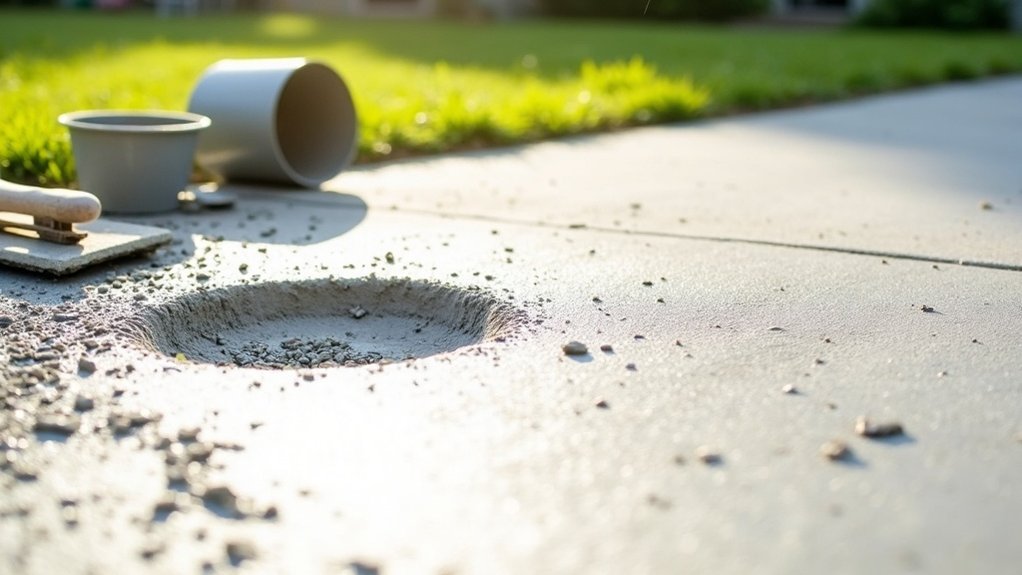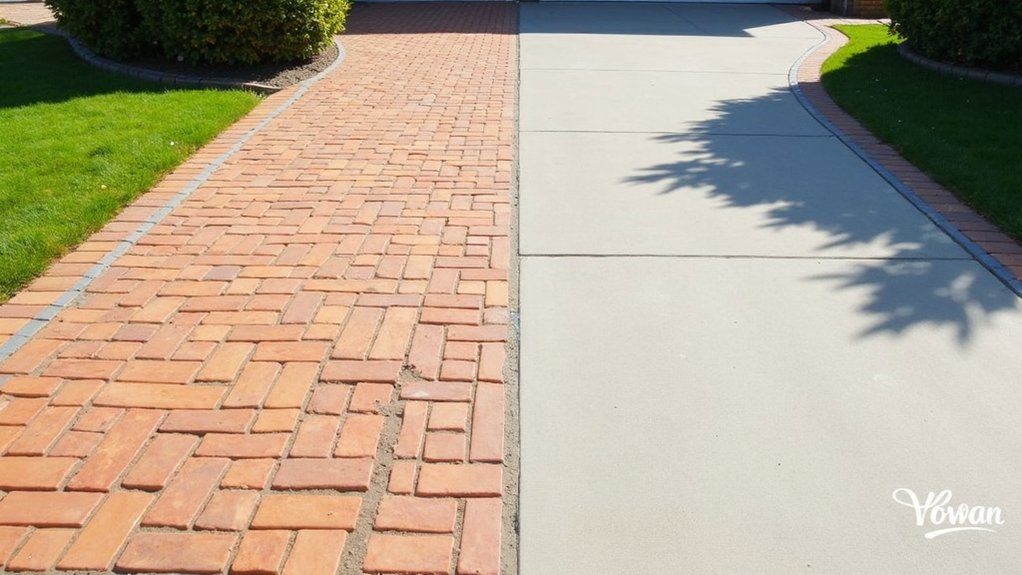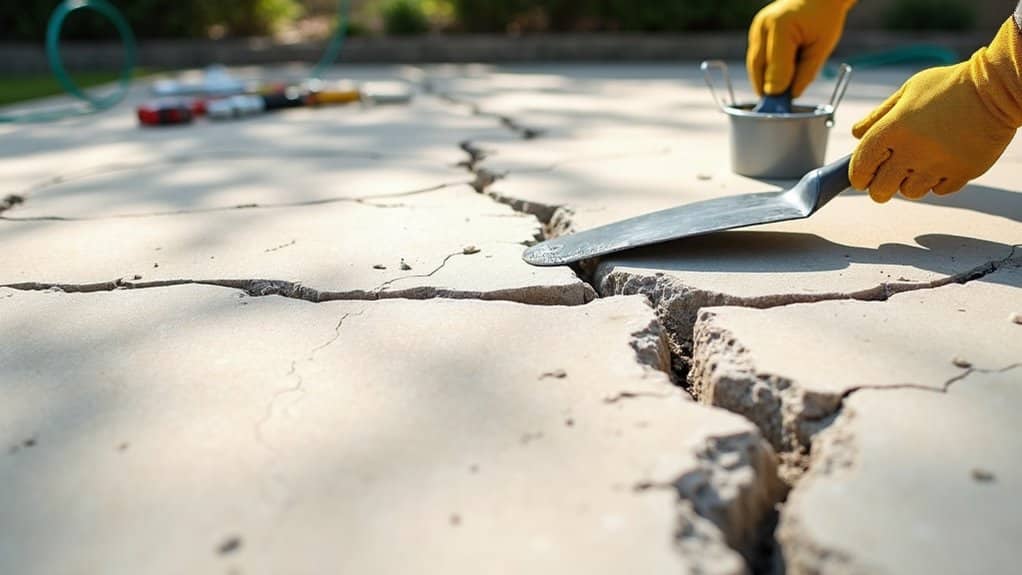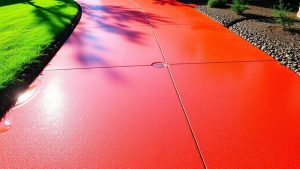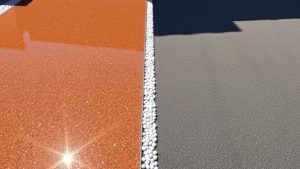To fix potholes in your concrete driveway, begin with full-depth patching for serious damage. This involves completely removing the compromised area and using quality concrete for the repair. For smaller issues, you might opt for slurry seals or cold patch compounds for a quick fix. Always ensure the surface is thoroughly prepared and use suitable bonding agents. Proper curing and sealing are crucial to prolonging the life of your repairs. By using the right techniques and materials, you can achieve effective and lasting results.
Table of Contents
ToggleKey Takeaways
- Carry out full-depth patching by removing the damaged concrete, checking the sub-base, and applying high-quality concrete. Use internal vibrators for added durability.
- For minor repairs, consider a slurry seal to fill small cracks. This helps extend the lifespan of your driveway while protecting it from moisture and UV damage.
- Employ spray injection techniques to quickly repair multiple potholes in a single day using cold bitumen emulsion and special aggregates.
- Use cold patch compounds for quick fixes in various temperatures, allowing for immediate traffic use after application.
- Ensure proper surface preparation by cleaning thoroughly, using bonding agents, and curing effectively to avoid premature cracking.
Understanding Pothole Damage in Concrete Driveways
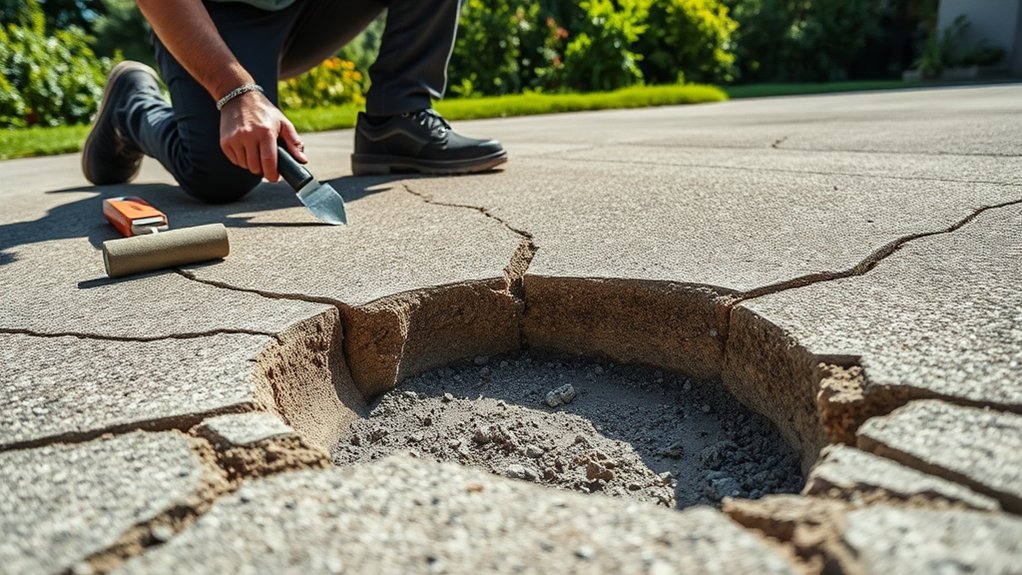
Pothole damage in concrete driveways typically arises from environmental factors and structural flaws. Key causes include moisture infiltration, plant growth, and temperature changes.
Water can seep into cracks, weakening the base and leading to deterioration. Tree roots may also worsen the situation by applying pressure on the concrete, causing further cracks.
Additionally, poor installation practices, such as insufficient compaction, can create vulnerabilities. To address these issues, it’s crucial to repair cracks promptly to stop moisture from entering and to enhance the concrete with effective drainage systems. Regular inspections are vital to identify potential problems before they escalate into larger issues.
Regular upkeep—keeping an eye out for plant growth and managing heavy loads—can significantly extend the lifespan of your driveway and reduce the chances of developing potholes in the future.
Full-Depth Patching: A Comprehensive Solution
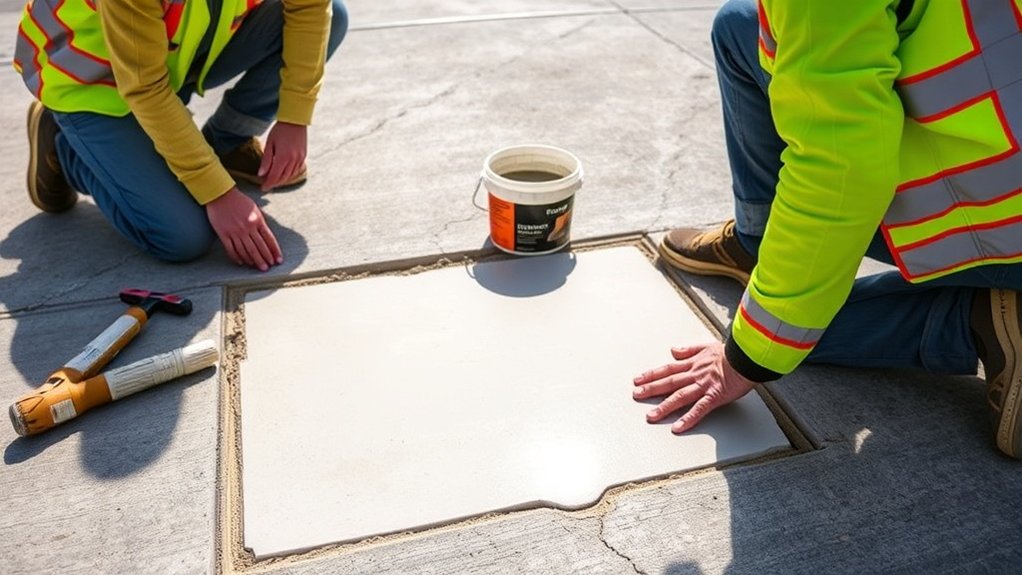
In full-depth patching, it’s essential to follow a structured approach for a successful repair. This includes choosing the right materials and applying them with specific techniques to ensure long-lasting results. For instance, using a high-quality concrete mix will help restore the strength of the surface. Additionally, addressing concrete crack types can significantly influence the effectiveness of the repair process.
Process Overview
When dealing with severe pavement deterioration, full-depth patching is an effective way to restore both strength and longevity. Start by marking the pothole edges with saw cuts to ensure clean lines. Remove all damaged concrete and check the subbase for any underlying issues, compacting new material as necessary. It’s crucial to keep the area dry, so make sure to remove any standing water. Pour the concrete directly from the trucks, spreading it evenly, and use internal vibrators to eliminate air pockets. To enhance driveway protection, consider applying a sealant after the repair to maintain its appearance and longevity. Finish the surface by levelling and texturing it to blend with the surrounding area. To ensure proper curing, cover the patch to retain moisture and avoid heavy traffic until it has fully set. These techniques will ensure a durable and long-lasting repair.
Material Requirements
Selecting the right materials for full-depth patching is crucial for ensuring a strong and long-lasting repair. Focus on material durability and compatibility to achieve a reliable solution. Here’s a brief overview of suitable materials for full-depth repairs:
| Material Type | Key Characteristics |
|---|---|
| Cement-based Grout | Needs precise sizing for dowel holes; complies with British standards. |
| Vinyl Concrete Patch | Flexible and sets quickly; perfect for thin applications. |
| Epoxy Adhesives | Strengthens structural integrity; ideal for anchoring tie and dowel bars. |
Proper preparation is essential. Clean surfaces and dampen repair areas to improve bonding. Select additives that complement your patch material for optimal adhesion and performance. This method ensures a dependable and durable repair.
Application Techniques
Applying full-depth patching techniques correctly is crucial for a lasting repair.
Begin by cutting the edges with a diamond blade saw to remove the damaged concrete accurately. Clean the area thoroughly and check the subbase for damage, adding compacted material if necessary. Use vibratory compactors for optimal stability.
When placing ready-mix concrete, spread it evenly and use mechanical tools to remove air pockets. Finish the surface with vibratory screeds to align with the surrounding driveway and apply textures for grip.
Lastly, keep the area moist during curing to prevent cracking. By following these steps, you’ll improve your concrete maintenance and provide a durable solution for potholes.
Partial-Depth Patching for Minor Repairs
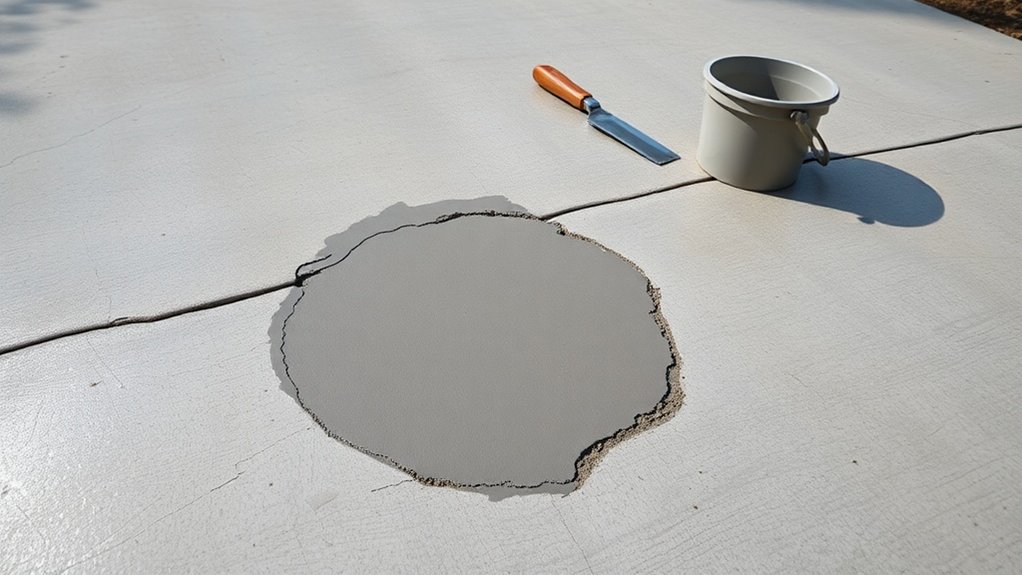
Partial-depth patching is a practical method for tackling minor surface issues in concrete slabs, like small spalls and shallow cracks. This technique focuses on damage that affects just the top third or half of the slab thickness, addressing localised problems without the need for complete replacement.
The benefits include restoring structural integrity and extending the lifespan of the concrete by preventing further deterioration.
To prepare for patching, you start by saw cutting to establish the boundaries of the patch, then remove all damaged material until you reach sound concrete.
It’s crucial to apply a bonding agent for proper adhesion, and careful placement of the repair material ensures that the original joint profiles are maintained.
Finishing and curing are important for durability, making partial-depth patching a sensible solution for minor repairs.
Utilizing Slurry Seal for Small Cracks
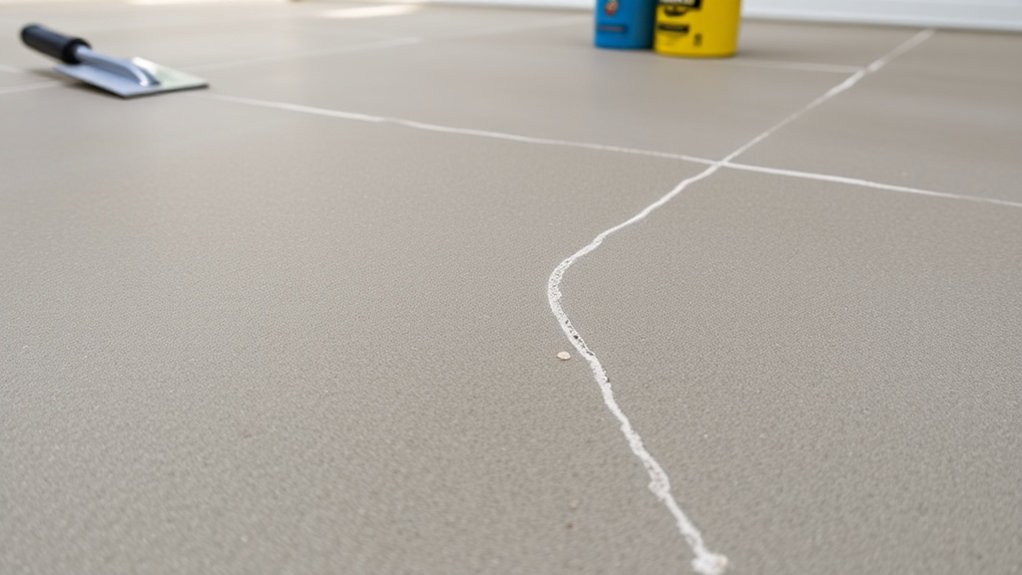
When dealing with small cracks in your pavement, using slurry seal can be an effective approach.
This blend of asphalt emulsion, fine aggregate, and additives not only seals the surface but also prolongs the lifespan of the pavement by preventing water from seeping in.
Knowing how to apply slurry seal and its advantages will help you make better choices for maintaining your asphalt surfaces.
Slurry Seal Composition
Using slurry seal for small cracks involves a precise mix of materials that enhance the longevity and performance of pavements. This composition ensures effective sealing and structural integrity, offering several benefits:
- Polymer-modified emulsified asphalt: This gives a smooth texture and improves flexibility.
- Mineral fillers: Substances like limestone dust and hydrated lime boost strength and durability.
- Carefully sized aggregates: Small crushed stones provide texture and resilience.
Slurry seal is perfect for treating narrow cracks and minor damage without needing extensive repairs.
Application Process Overview
The application process for slurry seal involves several key steps to ensure effective treatment of small cracks.
Start by thoroughly cleaning the concrete surface to remove any debris, which is vital for proper adhesion. Check for larger cracks, as these must be repaired separately to avoid future issues. Any cracks wider than 3mm should be sealed to prevent water infiltration, which is crucial for avoiding potholes.
Next, mix asphalt emulsion, mineral aggregate, and water in the correct proportions. Use a truck-mounted slurry seal machine for an even application, and complement this with hand tools for hard-to-reach areas.
Finally, allow the slurry to cure undisturbed for 24 to 48 hours, keeping it protected from traffic during this period. These concrete repair techniques help ensure long-lasting results and improved surface integrity.
Benefits of Slurry Seal
Slurry seal provides significant advantages for repairing small cracks in pavement, particularly in terms of cost-effectiveness and durability.
Here are some key benefits:
- Cost-Effective Application: Prices typically range from £1 to £3 per square metre, making it a much cheaper option than complete resurfacing.
- Extended Pavement Lifespan: It creates a protective layer that guards against moisture and UV damage, which can help avoid expensive repairs down the line.
- Improved Safety: The textured surface enhances skid resistance, offering better traction for both vehicles and pedestrians.
Using slurry seal is a smart choice for maintaining pavements efficiently and affordably.
Spray Injection Technique for Efficient Repair
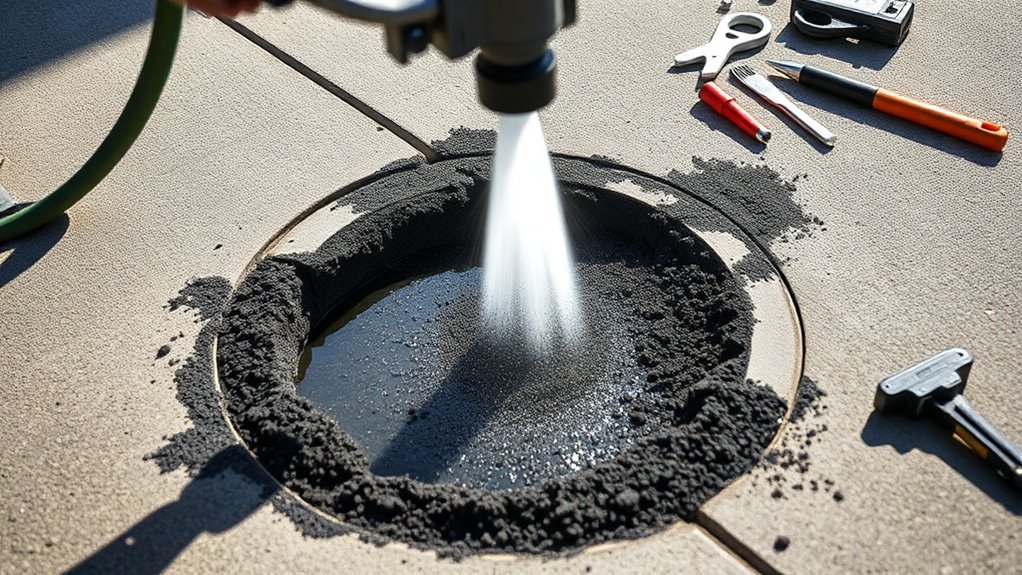
For efficient pothole repairs, the spray injection technique is a standout method. It uses compressed air to clean the area, ensuring optimal adhesion for the repair materials.
First, a cold bitumen emulsion is applied to seal the void, followed by a specially formulated aggregate mix to fill the pothole. A second layer of bitumen emulsion then provides a durable finish.
One of the key advantages of spray injection is its capacity to repair up to 200 defects in a single day, significantly increasing efficiency. This technique reduces manual labour, accelerates the repair process, and helps prevent water infiltration, which can worsen damage.
Quick Solutions With Cold Patch Compounds
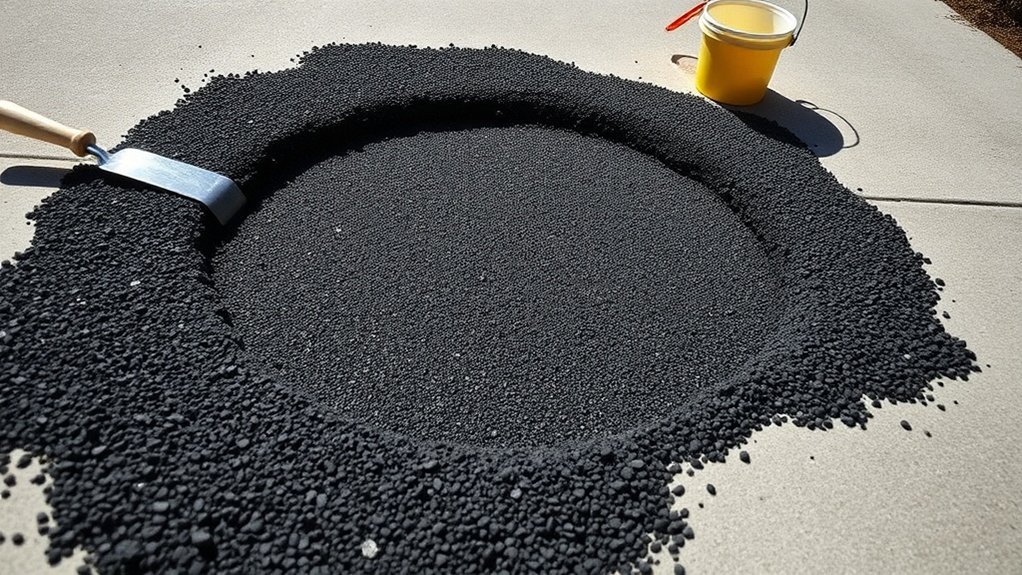
Pothole repairs often require swift action to prevent further damage to the road. Cold patch compounds offer an effective solution for quick restoration.
Here are some key benefits:
- Temperature versatility: Suitable for use in a range of temperatures, including below freezing, allowing for repairs all year round.
- Simple application: These products are easy to handle, meaning you can carry out repairs without the need for heating or mixing.
- Instant traffic usability: Many cold patch formulations allow for immediate traffic use after application, making the process efficient.
When using cold patches, ensure you apply in 1-inch layers for the best compaction and bonding.
This approach ensures your repairs are durable and effective, tackling potholes and surface defects with minimal disruption.
Essential Surface Preparation and Cleaning Steps
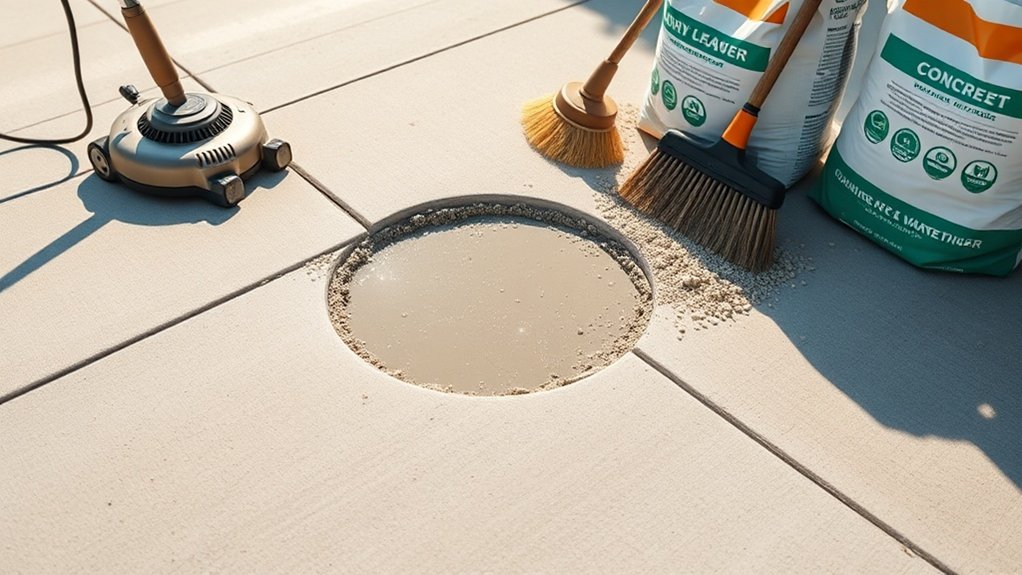
For a successful pothole repair, it’s crucial to follow key surface preparation and cleaning steps to ensure proper adhesion and durability of the patching materials.
Begin by removing any loose concrete using a cold chisel and sledgehammer. Undercut the edges to enhance adhesion, then roughen the interior surface for better grip.
Thorough cleaning is essential. Use a broom or leaf blower to clear away debris, followed by power washing with a mild detergent.
Ensure the area is completely dry before applying bonding agents. Once cleaned, apply these agents to all interior surfaces promptly with a stiff paintbrush for full coverage.
Finally, keep the work area clean to avoid re-contamination, ensuring optimal conditions for your patch materials to bond effectively.
Proper Material Selection and Mixing Techniques
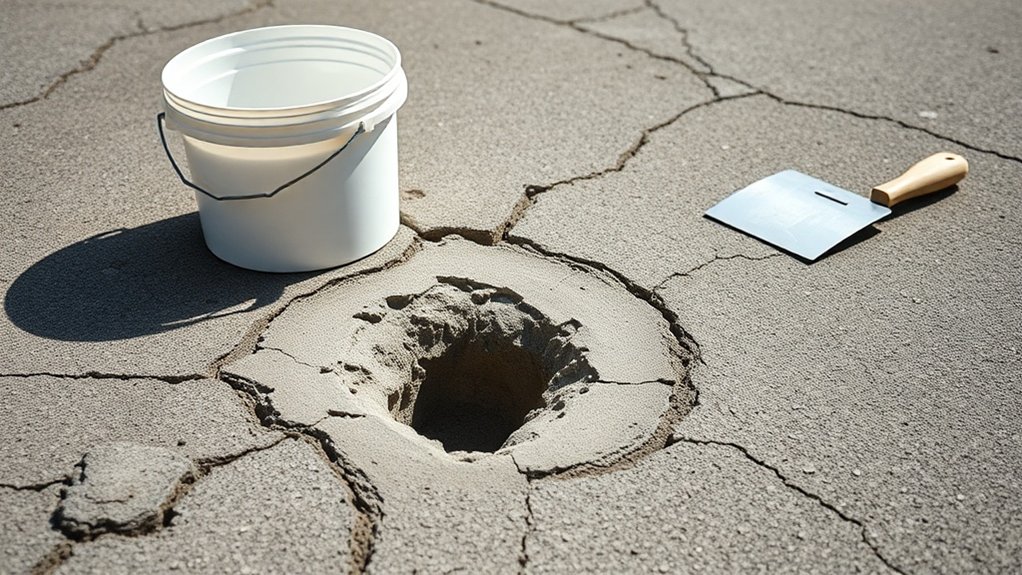
Once the surface is prepared and clean, the next step in effective pothole repair is selecting the right materials and using proper mixing techniques. Choosing the right material enhances durability and longevity.
Keep these key points in mind:
- Use high-strength concrete mixes that achieve 27-45 MPa for durability.
- Choose polymer-modified mortars for better adhesion and flexibility.
- Follow the manufacturer’s instructions for accurate water-to-mix ratios to ensure consistent mixing.
Only mix what you can apply within the working time to avoid stiffness. Using a mechanical mixer helps achieve uniformity, and adding water gradually maintains strength.
Curing and Sealing for Longevity of Repairs
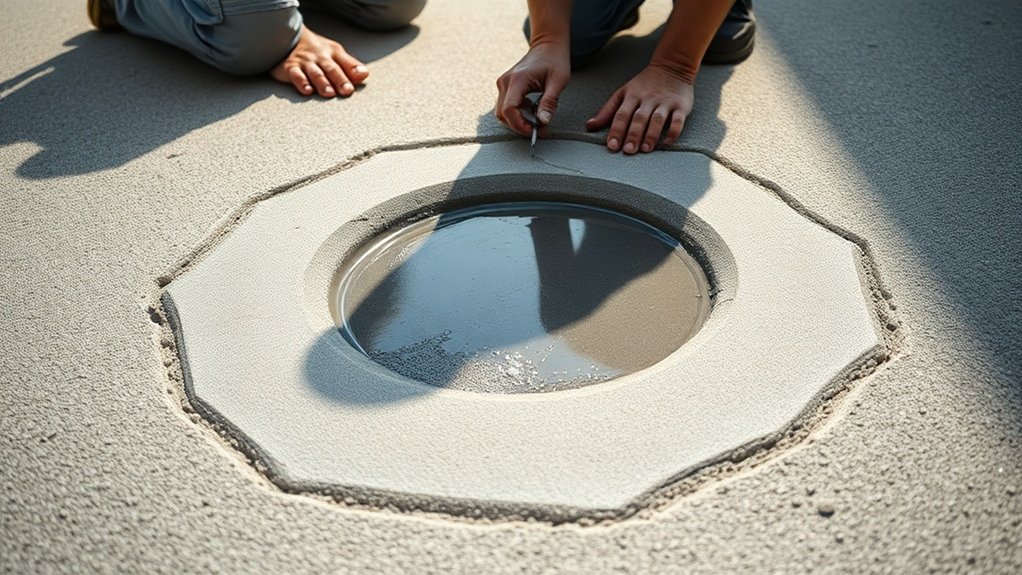
Effective curing and sealing are essential for the longevity of pothole repairs in concrete driveways. Proper curing methods, like moist curing and the use of curing compounds, prevent premature drying, which can lead to cracking and shrinkage.
Always follow the manufacturer’s specified curing times, typically between 24 and 72 hours, depending on environmental conditions.
Once the repair is fully cured, apply a suitable sealer to protect against water damage and freeze-thaw cycles. Select a sealer based on how the driveway is used, ensuring the surface is clean and adequately cured before application.
Adhere to the recommended number of coats and drying times for the best results. To maintain the integrity and appearance of your repairs, reseal your driveway every 2-3 years.
Frequently Asked Questions
How Can I Prevent Future Potholes in My Driveway?
To prevent future potholes in your driveway, focus on regular maintenance. Apply a sealant to protect the surface, check for cracks often, and fix them quickly. Ensure proper drainage to reduce water pooling, which can weaken your driveway. Regular upkeep will help prolong its life and keep it looking good.
What Are the Signs of Severe Concrete Damage?
Concrete is like skin; when it cracks, it signals deeper issues. Look out for expanding cracks, surface wear, and signs such as spalling or efflorescence. These are indicators of significant structural problems that require immediate attention to prevent further damage.
Can I Fix Potholes in Winter Conditions?
You can attempt pothole repairs in winter, but cold weather makes proper curing difficult. Ensure you use materials rated for cold weather, clean the area thoroughly, and avoid major repairs when temperatures are below 4°C to prevent weak, temporary results.
How Long Should I Wait Before Driving on a Repaired Patch?
You should wait at least 24 to 48 hours after a repair before allowing light foot traffic on the patch. However, it’s best to avoid driving on it for a full week to ensure the concrete cures properly and achieves maximum strength.
Are There Any Eco-Friendly Repair Options Available?
You can opt for eco-friendly repair solutions such as recycled materials and sustainable practices. For instance, consider using permeable paving for your driveway. This not only reduces surface runoff but also integrates seamlessly with the natural surroundings, providing a robust surface that benefits both your home and the environment.
Conclusion
In summary, fixing potholes in your concrete driveway not only improves its appearance but also enhances your home’s appeal. Techniques like full-depth patching and appropriate surface preparation are essential for a long-lasting solution. With the right materials and a bit of effort, you can effectively smooth out those imperfections, ensuring a safe and inviting entrance for years to come. Your driveway deserves a proper repair.
Learn about the lifespan and durability of concrete driveways, and discover essential tips to ensure yours lasts for decades to Read more
On a budget? Discover how block paving and concrete driveways compare in costs and long-term value—your wallet might thank you!
Observe the best techniques to repair cracks in your concrete driveway, and discover the secrets to ensuring a long-lasting, durable Read more

